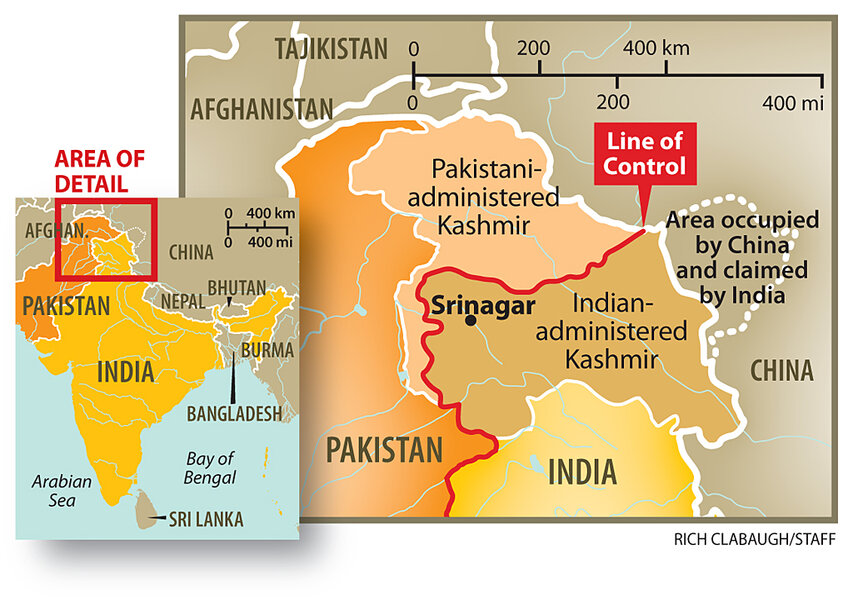Kashmir protests: Intifada comes to Kashmir
Loading...
| Srinagar, India
Since witnessing the beating of two men in the street last month by paramilitaries, one young Kashmiri, at work on a science doctorate, has joined the ranks of a new rock-throwing youth uprising.
"I felt proud that I did not remain silent like our elders," he says.
This summer, hundreds of "rock pelters" ages 6 to 30 have clashed with security forces across Indian-controlled Kashmir.
These young men are determined to be the generation that wins self-determination for Kashmiris.
Heavy-handed police tactics have turned youths into rock throwers and devoted adherents of a once-fading Kashmiri separatist movement.
What they're fighting for
After more than 60 years of separatist conflict in the disputed region of Kashmir, where India, Pakistan, China, and the Muslim-majority people of Kashmir wrestle for control, it's clear to these youths that guns aren't the way. Instead, they have turned to rocks and nonviolent protests in an effort to send a message to India that Kashmiris are serious about autonomy.
"We know what India did in the '90s. We had an armed struggle going on in Kashmir. That was quite unproductive for us," says the doctoral student. "Why is there stone throwing all around Kashmir? We have no other way. We cannot hold any demonstrations."
Police say they must stop rallies before they turn into rock-pelting mobs, while the rock pelters say they throw stones because they cannot rally and, when they do, innocents are killed by the police.
Kasmir Valley in lockdown
For the past two months, the Kashmir Valley has been in lockdown after this cycle of violence left some 46 dead. Among them: a 9-year-old boy and a 17-year-old girl. Over the weekend, the protests and police response grew more intense. Despite the announced dispatch of more paramilitary police to the Valley, and warnings to residents that they would be shot on sight if they defied curfews, tens of thousands of Kashmiris have taken to the streets.
Parts of Srinagar feel like a prison, with shops shuttered, residents peering out of windows, and groups of security forces clustered on street corners. Residents who do venture out mostly go solo, so as not to attract attention. The two men beaten in the street after curfew, says the doctoral student, had special passes. But paramilitaries forced them back indoors.
The student and other stone throwers interviewed would not share their full names for fear of police reprisals. He wanted to stress that "India is trying to portray the stone pelters as illiterate," he says. "Or too poor that they are paid 50 rupees to throw stones," chimes in 22-year-old Nadeem.
All of the youths interviewed had jobs and denied that economics played a role in their unrest.
'We want peaceful protests'
Nadeem is not a rock pelter – yet. "I go on in the processions, and I am raising slogans against India," he says.
"We want peaceful protests to be stronger than stone pelting."
Nadeem doesn't disagree with the choices made by the stone pelters in the room – and vice versa.
Ubaid, age 21, started in 2007 after police accused him of throwing stones and beat him. Umar, 30, started in 2008 after he witnessed the shooting of an innocent bystander.
Shabir, 29, and Shafad, 25, both say they started stone throwing in 2008 in response to police crackdowns on massive protests that erupted over a state government land transfer to accommodate a Hindu pilgrimage. Most observers say '08 marked the beginning of this latest generation of protest.
Kashmiri separatism was once something that teens knew little about, says the doctoral student. "Now our youngsters are interested." Shabir and he say that they pay attention to separatist leaders, known as the All Parties Huriyat Conference, but the connection is indirect.
"When [the Huriyat] announce protests, they do it publicly, and we come and support it," says Shabir. "There is no organization; people just come and join."
Huriyat leaders, meanwhile, worry that what influence they have on the youths will fade if New Delhi does not try to settle the dispute.
Related:






